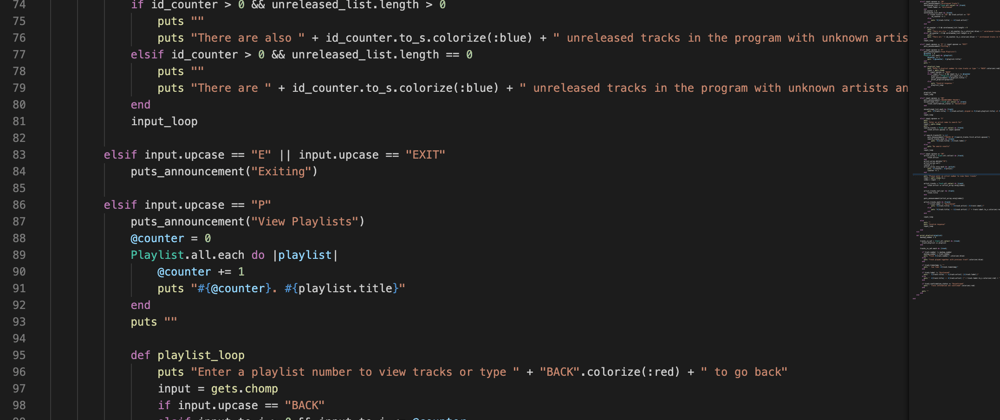Now that I'm a little over a month into my journey with Flatiron School, I was asked to make a Ruby application with data from an API or from a web page. After searching for a project to sink my teeth into, I decided to create a program that helps me with one of my pastime interests -- tracking songs (more often called tracks) played by my favorite DJ's.
Background on Electronic Music
In the electronic music world, a lot of listeners are interested to know what track a DJ is playing or has played in the past. In fact, the interest is so strong that there are community-sourced websites where users can identify tracks a DJ has played. A lot of times, a DJ will play a track that has not been released on a record label or will even play tracks that users know nothing about (an unknown track).
As an avid track-identifier myself, I wanted to build a Ruby program that would let me add as many or few playlists as I wanted and then be able to search the tracks for ones that are not released or ones that are missing information.
Program Architecture
Since 1001 Tracklists does not have an API, I decided to scrape data using nokogiri and open-uri gems.
My program, DJ Booth is made up of four basic classes, Track, Playlist, Scraper, and CLI. Objects indirectly relate to one another except for Track and Playlist which have a 'belongs-to, has-many relationship' in that Track belongs to a Playlist and stores this information as an object in its @playlist attribute accessor.
The CLI class houses the UI of the program and also decides when new Scraper classes are created and a new Playlist is added to the program. The CLI class also handles a variety of ways to view instances of Playlist and Track using their .all methods.
All classes are contained in their own file in a lib directory and are linked together in one enviornment file using require_relative. The bin directory contains only one file with no extension and a shebang line declaring the language as ruby.
Scraper Class
The Scraper class is instantiated every time a user adds a new Playlist. The Scraper contains several instance methods, #initialize, #get_page, #get_tracks, and #make_tracks. Each time a Scraper in instantiated it creates a new Playlist and stores it in its @playlist instance variable.
The scraper first gets a specific website using
def get_page
doc = Nokogiri::HTML(open(@input))
@playlist.title = doc.css("#pageTitle").text
doc
end
def get_tracks
self.get_page.css(".tlpItem")
end
The program then enumerates through each track listing on the website using the #each method and then calling Track.new and assigning its attributes to information on the website.
CLI Class
The CLI class relies on one major instance method called input_loop which is called within itself to go back to the main menu unless the user wishes to exit the program. On the main menu Track.all.count and Playlist.all.count are called to let the user know how many instances of Playlist and Track are loaded in the program.

The user can then view the objects in a variety of ways that use enumerator methods to show the data back to the user. Selecting "UR" will show the user Tracks that have a #label of "Unreleased" and puts them out using string interpolation
id_counter = 0
unreleased_list.each do |track|
if track.title == "ID" && track.artist == "ID"
id_counter += 1
else
puts "#{track.title} -- #{track.artist}"
end
end
This method also counts tracks that are missing their name and artist and returns it in a string using the colorize gem.
if id_counter > 0 && unreleased_list.length > 0
puts ""
puts "There are also " + id_counter.to_s.colorize(:blue) + " unreleased tracks in the program with unknown artists and unknown track titles."
elsif id_counter > 0 && unreleased_list.length == 0
puts ""
puts "There are " + id_counter.to_s.colorize(:blue) + " unreleased tracks in the program with unknown artists and unknown track titles."
end
Refactoring Code
As I wrapped up this project, it became apparent there are several opportunities to refactor my code:
- Several methods in the
CLIclass do not fit the single-responsibility principle (SRP) - Classes should manage the instantiation of their own instances. (Currently a
Trackis created and passed in information from theCLIclass. - The
#input_loopmethod is 130+ lines of code. Each selection from the menu should be broken into its own method. - The program could manage a new object
Artistto whichTrackbelongs-to.







Top comments (0)